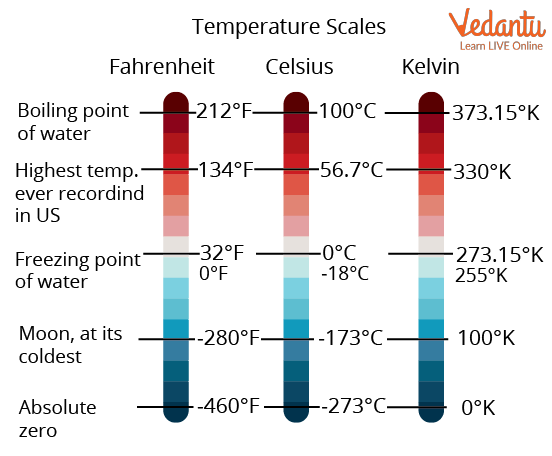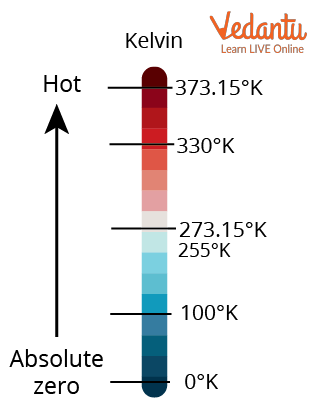




Quick Guide: Celsius, Fahrenheit, and Kelvin Differences for Students
Hello kids, have you ever fallen ill and your body is too hot when you touch it? Have you imagined why it is hot? It is because of the temperature. Now, let us understand what temperature is and what types of temperatures. Temperature is the heat present in any substance. It can be measured on our body or in a cup of tea also.
Thermometers measure temperature as per size. The three most normal temperature scales are Fahrenheit, Celsius, and Kelvin. Temperature scales are made by distinguishing two temperatures. The freezing and boiling temperatures of water at standard atmospheric pressure are generally used here.

Temperature Scales
Types of Temperature
Fahrenheit Scale
Fahrenheit temperature scale is a scale in light of 32 for the edge of freezing over of water and 212 for the limit of water, the stretch between the two being partitioned into 180 parts. The eighteenth-century German physicist Daniel Gabriel Fahrenheit initially took as the zero of his scale the temperature of an equivalent ice-salt blend and chose the upsides of 30 and 90 for the freezing point of water and normal body temperature, separately; these later were modified to 32 and 96, however, the last scale expected a change in accordance with 98.6 for the last option esteem.
Until the 1970s the Fahrenheit temperature scale was in everyday normal use in English-talking nations; the Celsius, or centigrade, scale was utilized in most different nations and for logical purposes around the world. Since that time, in any case, most English-talking nations have formally embraced the Celsius scale.
The conversion for a temperature that is expressed on the Celsius (C) scale to its Fahrenheit (F) portrayal is:
F = 9/5C + 32.
Celsius Scale
The Celsius temperature scale, likewise called the centigrade temperature scale, is the scale in light of 0 for the edge of the freezing point of water and 100 for the limit of water. Imagined in 1742 by the Swedish cosmologist Anders Celsius, it is at times called the centigrade scale on account of the 100-degree span between the characterized focuses.
The accompanying equation can be utilized to change over a temperature from its portrayal on the Fahrenheit ( F) scale to the Celsius (C) esteem:
C = 5/9(F - 32).
The Celsius scale is overall utilized in any place metric units have become acknowledged, and it is utilized in logical work all over the place.
Kelvin Scale
The Kelvin temperature scale is the base unit of thermodynamic temperature estimation in the International System (SI) of estimation. It is characterized as 1/273.16 of the triple point of unadulterated water. The Kelvin (image K without the degree sign []) is likewise the essential unit of the Kelvin scale, an absolute scale of temperature named for the British physicist William Thomson, Baron Kelvin.
Such a scale has as its zero point outright zero, the theoretical temperature at which the particles of a substance have the least energy.

Scales of Temperature
Summary
Three sorts of thermometers are alcohol, liquid crystal, and infrared radiation (pyrometer). The three primary temperature scales are Celsius, Fahrenheit, and Kelvin.
Temperatures can be changed over starting with one scale and then onto the next utilizing temperature transformation conditions.
The three periods of water (ice, fluid endlessly water fume) can exist together at a single pressure and temperature known as the triple point. The thermometer is used by doctors and we also use it in our home whenever we fall ill.
FAQs on What Are the Three Main Temperature Scales?
1. What are the three main scales used to measure temperature?
The three most common scales used for measuring temperature are Celsius (°C), Fahrenheit (°F), and Kelvin (K). The Celsius scale is part of the metric system and is used worldwide. The Fahrenheit scale is primarily used in the United States. The Kelvin scale is the standard for scientific measurements as it is an absolute temperature scale.
2. What are the freezing and boiling points of water on the Celsius, Fahrenheit, and Kelvin scales?
The freezing and boiling points of water are fundamental reference points for temperature scales. Here is a comparison:
- Celsius (°C): Water freezes at 0°C and boils at 100°C.
- Fahrenheit (°F): Water freezes at 32°F and boils at 212°F.
- Kelvin (K): Water freezes at 273.15 K and boils at 373.15 K.
3. How is normal human body temperature represented on the Celsius and Fahrenheit scales?
Normal human body temperature is a common real-world example of temperature measurement. It is generally accepted as 37°C on the Celsius scale and 98.6°F on the Fahrenheit scale. A significant deviation from this range can indicate a fever or other medical condition.
4. How are the Celsius, Fahrenheit, and Kelvin scales related to each other?
The three temperature scales are related by specific mathematical formulas, which allow for conversion between them. The primary relationships are:
- Celsius to Fahrenheit: °F = (°C × 9/5) + 32
- Celsius to Kelvin: K = °C + 273.15
- Fahrenheit to Celsius: °C = (°F - 32) × 5/9
These formulas help in standardising temperature readings across different systems and applications.
5. Why is the Kelvin scale preferred for scientific work?
The Kelvin scale is preferred in science because it is an absolute temperature scale. Its starting point, 0 K, is known as absolute zero—the theoretical temperature at which all molecular motion ceases. This makes it directly proportional to the kinetic energy of particles, simplifying many scientific laws and formulas, particularly in physics and chemistry. Unlike Celsius and Fahrenheit, the Kelvin scale has no negative numbers.
6. Why can't you use a standard clinical thermometer to measure the temperature of boiling water?
A standard clinical thermometer is designed specifically to measure human body temperature and has a very limited range, typically from about 35°C to 42°C (95°F to 108°F). The boiling point of water is 100°C (212°F), which is far beyond the maximum temperature a clinical thermometer can read. Exposing it to such high heat would cause the liquid inside (mercury or galinstan) to expand excessively and break the glass tube.
7. Besides Celsius, Fahrenheit, and Kelvin, are there other temperature scales?
Yes, while Celsius, Fahrenheit, and Kelvin are the most widely used, other scales exist, though they are less common or used for specialised purposes. The most notable one is the Rankine scale (°R). Like Kelvin, it is an absolute scale, but its degrees are the same size as Fahrenheit degrees. Absolute zero on the Rankine scale is 0 °R, which is equal to -459.67°F.























